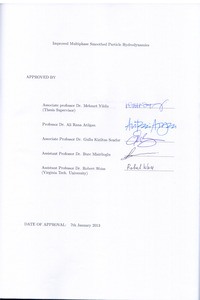Safdari Shadloo, Mostafa (2013) Improved multiphase smoothed particle hydrodynamics. [Thesis]
MostafaSafdariShadloo_459954.pdf
Download (9MB)
![[thumbnail of Approved_By.bmp]](https://research.sabanciuniv.edu/26557/2.hassmallThumbnailVersion/Approved_By.bmp)

Preview
Approved_By.bmp
Download (10MB) | Preview
Official URL: http://192.168.1.20/record=b1505283 (Table of Contents)
Abstract
Smoothed Particle Hydrodynamics (SPH) is a relatively new meshless numerical approach which has attracted significant attention in the last 15 years. Compared with the conventional mesh-dependent computational fluid dynamics (CFD) methods, the SPH approach exhibits unique advantages in modeling multiphase fluid flows and associated transport phenomena due to its capabilities of handling complex material surface behavior as well as modeling complicated physics in a relatively simple manner. On the other hand, as SPH is still a developing CFD tool, it is vital to investigate its attributes, namely, advantages or potential limitations in modeling different multiphase flow problems to further understand and then improve this technique. Toward this end, this work aims to design a computational code using SPH method for the simulation of multiphase flows. In this work, we present numerical solutions for flow over an airfoil and square obstacle using both weakly compressible and incompressible SPH method with an improved solid boundary treatment approach, referred to as Multiple Boundary Tangents (MBT) method. It is shown that the MBT boundary treatment technique is very effective for tackling boundaries of complex shapes. Also, we have proposed the usage of the repulsive component of the Leonard Jones Potential (LJP) in the advection equation to repair particle fracture occurring in SPH method due to the tendency of SPH particles to follow the stream line trajectory. This approach is named as the artificial particle displacement method. Furthermore, the proposed method is totalized for the multiphase uid systems and implemented accordingly. The presented model is validated by solving Laplace's law, and square bubble deformation without surface tension whereby it is shown that the implemented SPH discretization does not produce any artificial surface tension. Then, the problem descriptions and solutions for two important hydrodynamic instabilities namely, Kelvin-Helmholtz and Rayleigh-Taylor instabilities, are provided along with their brief analytical linear stability analysis to describe the accuracy and the limitation of the numerical scheme. The long time evolution for both cases are investigated and the comparison between the simulation results and existence theories are provided in details. Finally, we have presented a model to study the deformation of a droplet suspended in a quiescent fluid subjected to the combined effects of surface tension and electric field forces. The electrostatics phenomena are coupled to hydrodynamics through the solution of a set of Maxwell equations. The relevant Maxwell equations and associated interface conditions are simplified relying on the assumptions of the so called leaky dielectric model. All governing equations and the relevant jump and boundary conditions are discretized in space using the SPH method with improved interface and boundary treatments. Numerical results are validated by two highly credential analytical results which are frequently cited in the literature.
| Item Type: | Thesis |
|---|---|
| Uncontrolled Keywords: | Smoothed particle hydrodynamics. -- Meshless method. -- Multiple boundary tangents (MBT) method. -- Multi-phase fluid flows. -- Continuum surface force (CSF). -- Hydrodynamic instability. Electrohydrodynamics. |
| Subjects: | T Technology > TJ Mechanical engineering and machinery > TJ163.12 Mechatronics |
| Divisions: | Faculty of Engineering and Natural Sciences > Academic programs > Mechatronics Faculty of Engineering and Natural Sciences |
| Depositing User: | IC-Cataloging |
| Date Deposited: | 21 Dec 2014 21:35 |
| Last Modified: | 26 Apr 2022 10:03 |
| URI: | https://research.sabanciuniv.edu/id/eprint/26557 |


